May 2023
- English
- 日本語
Massive Sea Bream Floats on Parade: The Tai Matsuri Festival in Toyohama Harbor
-
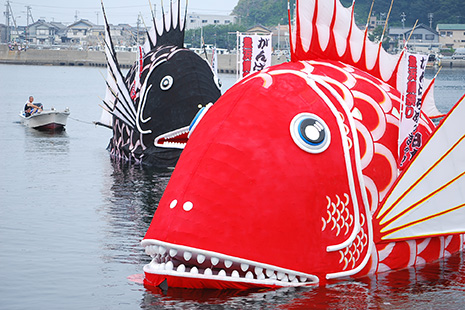
Tai Mikoshi or "Omoitsuki" are names locals use for the sea bream-shaped papier-mache. ©Minamichita -
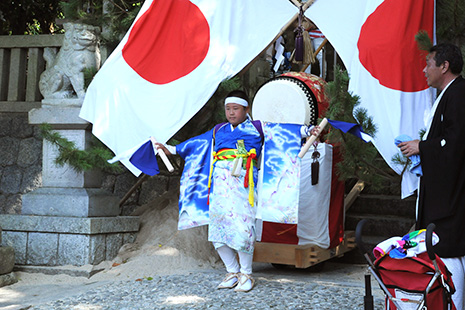
Along with the sea bream floats and portable shrines, young people perform with taiko drums.
-
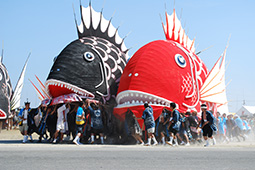
Massive papier-mache sea bream created with bleached cotton wrapped all around frames built of bamboo or wood and decorated. -
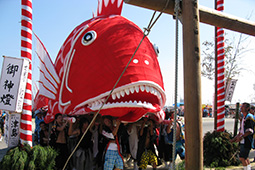
An energetic dedication of a sea bream float at an okariya (a provisional shrine built to temporarily house a kami deity) of Tsushima Shrine. -
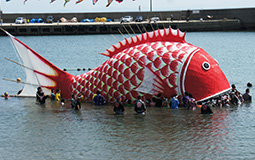
A massive sea bream mikoshi from the Nakasu district seen floating in the sea in the 2014 festival.

The Tai Matsuri, or Sea Bream Festival, takes place every July in Toyohama harbor in Minamichita Town, Aichi Prefecture. Serving to pray for bountiful catches of fish and seafaring safety, the lively festival features processions of massive hariko* (papier-machel) Tai Mikoshi (float or sacred palanquin), over 10 meters in length, along the seaside and through the town.
Near the center of the Japanese archipelago sits Aichi Prefecture, which borders the Pacific Ocean at its south. Toward the western part of the prefecture, where its central city of Nagoya is located, the Chita Peninsula extends to the south (see map). At the southernmost tip of the peninsula is Minamichita Town, with a flourishing fishing industry, with catches of whitebait, Japanese sea bass, black sea bream, and gold-lined seabream that rank in the top class in all of Japan.** The town has seven fishing harbors, the largest of which is Toyohama.
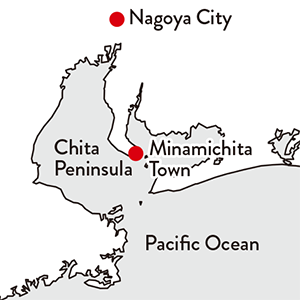
The five districts neighboring the Toyohama fishing port work in cooperation to hold an eccentric festival called the Tai Matsuri, or Sea Bream Festival, every year. The festival is said to have begun about 150 years ago with a papier-mache mouse. Subsequently, a variety of different papier-mache shapes were added, from elephants to shrimp. At the dawn of the 20th century, the large sea bream papier-mache mikoshi seen today came into prominence. Eventually, the style shifted to its present form, with huge sea bream papier-machemikoshi that travel around the town in processions, and even into the sea. The reason the mikoshi are shaped like a sea bream is that this festival is held to pray for large catches of fish. There is also a theory that the custom originated from the sea bream which depictions of Ebisu, the guardian deity of fishermen, often include.
Currently, the five districts neighboring Toyohama hold the two-day festival, competing to create large sea bream floats measuring from 10 to 18 m in length.

The festival is held at two locations in the town: the Susa district, which encompasses four wards,*** and the Nakasu district. Presently, the Susa festival takes place as the event for the local Tsushima Shrine. On the first day, they hold a ceremony that involves housing the kami deity in a temporary shrine called an okariya constructed near the seaside. A mikoshi portable shrine from the Susa district heads out to receive the kami, escorted by tai mikoshi sea bream portable shrine, and together they go parading about the town. The floats are heavy, weighing over a ton, and the sight of around 60 young people carrying them is inspiring. A fireworks display held in dedication presents a lively end to the first day.

On the second day, starting at 7am, boats tow the Susa district's four floats into the sea for a while. After that, the floats go parading around the town. Meanwhile, the Nakasu district's sea bream festival lasts for only one day until late at night, but it includes the procession of a sea bream mikoshi 14 meters in length. One of the festival's highlights occurs when locals pull the float into the sea with their own strength where it floats for about an hour. And an illumination of it at night presents a different appearance than during the day.
Taiko drummers who join the sea bream floats in the procession through the town contribute to the festive atmosphere. While in the past it was children from distinguished families in the district who participated, today there is a lottery system in place. Another highlight is the extravagant costumes—some people say each one used to cost as much as building a house.

The Tai Matsuri, or Sea Bream Festival, draws large crowds of people who turn out for the lively spectacle of the sea bream floats. For the three years from 2020 through 2022, it was suspended due to Covid-19 concerns. While the festival is scheduled to take place on July 23 this year, 2023, apparently there will unfortunately be no procession of sea bream mikoshi. The day when the spectacle of their spirited procession can safely be viewed once again will hopefully return as quickly as possible.

* Decorative floats that appear in festival processions. They are made by applying many layers of paper and other materials to frames made of wood, bamboo, or similar materials.
** According to 2014–2018 records from Chita-gun Minamichita-cho Gyogyo no Gaiyo ("Overview of the Fishing Industry in Minamichita Town, Chita District," 2020).
*** The four districts are: Nakamura, Torii, Hantsuki, and Tobu

